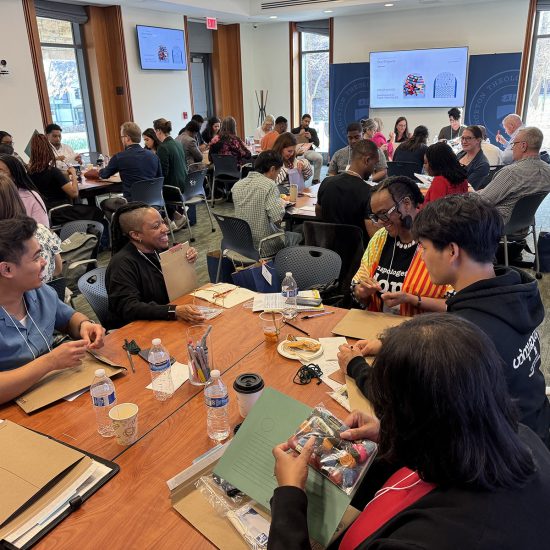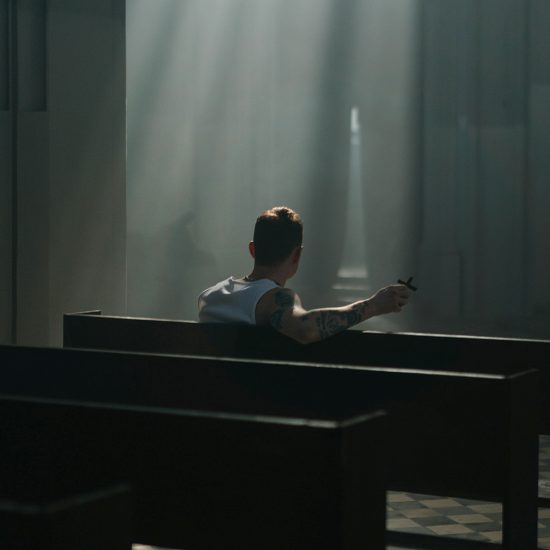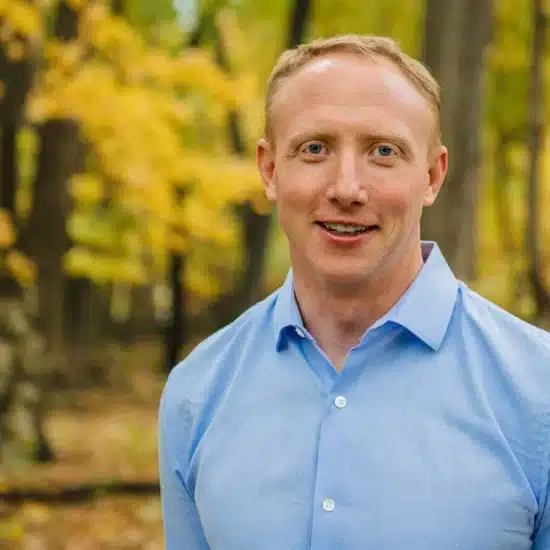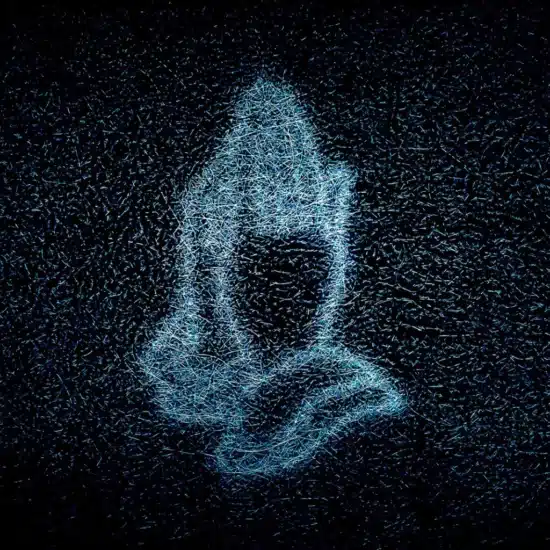MADISON, N.C. — One stitch at a time, the prayer shawl ministry at First Baptist Church of Madison, N.C., has created a network of love and blessing that has touched more than 1,250 people since its modest beginnings six years ago. The colorful shawls, scarves and lap robes the women knit or crochet have comforted or celebrated people within the small church and around the town and in other states and countries, as far away as the West Coast and the Czech Republic.
But the more than 20 women who make the shawls say the ministry’s greatest blessing may come to them.
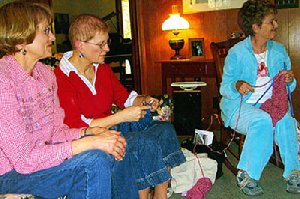
Prayer shawl ministry members (from left) Norma Elrod, Joyce Fulcher and Judy Washburn knitting at a meeting.
|
The idea arose after Joyce Fulcher, a longtime First Baptist member, stumbled upon an intriguing website on the Internet. Recently retired from teaching, Fulcher had been looking for a meaningful way to serve others. The website, www.shawlministry.com, told how Janet Bristow and Victoria Galo dreamed up a prayer shawl ministry in 1998 after attending a program in “applied feminist spirituality” at Hartford (Conn.) Seminary.
Fulcher mentioned the idea to a few people, including Marcia McQueen, the church’s interim pastor at the time. Almost at once, Fulcher began hearing stories about people’s friends or relatives who had experience with shawl ministries.
“I began to think we’re supposed to do this, because it keeps coming back,” Fulcher said.
Six people responded to an invitation in the church bulletin. There was only one problem: Almost none of them knew how to knit.
So at the early meetings of the prayer shawl ministry, Fulcher and another experienced knitter taught the craft to the others. From that beginning, the ministry has grown much as a first row of stitches grows into a colorful, intricate shawl.
When the church’s new pastor, Chuck McGathy, arrived, he was enthusiastic. A former U.S. Navy chaplain, he had been comforted by a prayer shawl when his first wife died years earlier.
Today, most of the participants are members of First Baptist, but some are from other churches and denominations. One woman joined the shawl ministry and later joined the church.
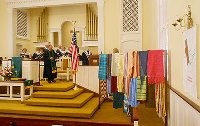
Prayer shawls are displayed prominently in the sanctuary of First Baptist Church, Madison, N.C., during a service of blessing for the handiwork.
|
They’ve progressed past elementary patterns to intricate designs. Shawl ministries vary from church to church, with some sticking to sedate patterns and colors. But at First Baptist, when a month’s worth of shawls are hung in the church to be blessed, a riot of bright hues and bold designs brightens the sanctuary.
“We want to be creative and put ourselves into it,” Fulcher said. “The people who get them know you spent a lot of time and energy focused on them.”
Shawls are mailed to distant recipients. Members of the group, and people in the congregation and community, personally deliver many others — another way of connecting with people. Each gift comes with a card saying “… into each row are woven prayers for you …” and explaining how the each pattern involves multiples of three to “… remind you of the Trinity’s constant presence both in and around you always.”
Part of each monthly gathering at Fulcher’s house is devoted to reading cards of thanks and sharing stories. The heartwarming stories shared at the meetings often involve a shawl arriving at just the right moment, when someone’s spirits were low or faith needed renewal. People insist that, even though they don’t believe in “magic,” they feel better when the shawl is with them. Jane Scruggs, one of the members, said, “It amazes me that people who don’t know anything about prayer shawls still feel the power when they get one.”
Recipients take the shawls with them when they have surgery. They keep them close when they are living in nursing facilities. Some people are buried with them.
Several of the knitters have become recipients and know firsthand how a shawl can help overcome depression or grief.
The members talk about how the blessings of the prayer shawl spread in ripples, touching the person who knits it, those who pray over it, the one who delivers it, the one who receives it and the ones who love that person.
Shawls and scarves go out for happy occasions too, as part of deacon ordinations, to new church members and for graduations and births. They are used in the church’s other ministries, such as Kid’s Hope and GriefShare, and they are sent regularly to the local hospice home and an elder-abuse program.
Word has spread throughout the community. People from other churches request shawls. Listeners to the Sunday morning radio broadcasts call the church office to inquire. Madison’s police chief took one to the widow of a police officer killed in the line of duty in nearby Winston-Salem.
And people donate yarn that they find on sale, at thrift stores, in attics. The main criterion for yarn, Fulcher said, is that it can’t be rough or stiff.
“A hug is soft,” she said.
Linda Brinson is a Religious Herald contributing writer, based in Madison, N.C.

